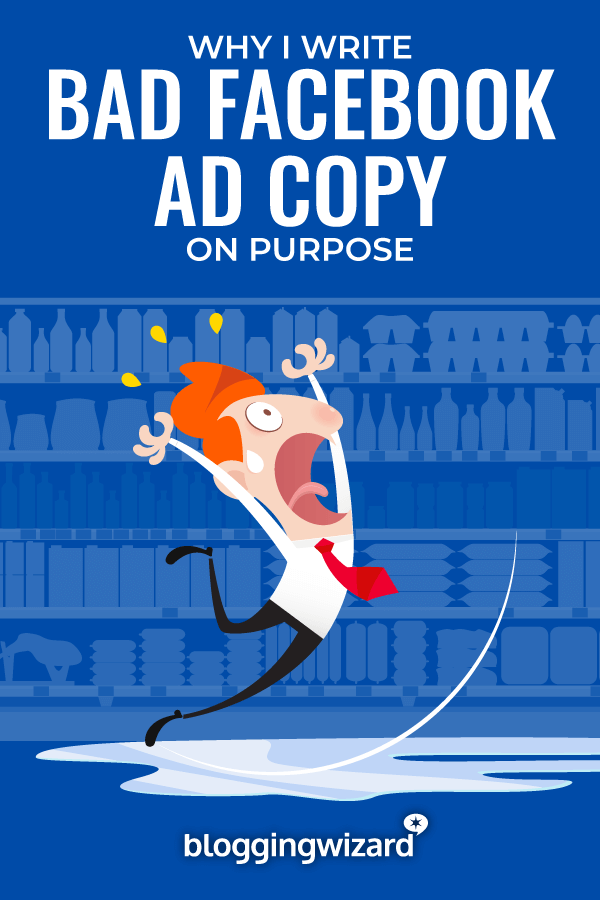Why I Write Bad Facebook Ad Copy On Purpose

You might think I’m out of my mind when I say this…
Every so often I write bad Facebook Ad copy on purpose.
But don’t worry. I haven’t lost my mind.
There is a method to my madness and in this post I’ll explain everything. Including my approach to Facebook Ads.
And, stick around to the end to learn why I intentionally throw money at Facebook Ads that provide zero ROI.
Let’s get into it.
Intentionally bad copy validates good copy
So, what’s the method to my madness?
Sometimes we need to tip convention on its head. Then shake it a little bit and see what happens. And we need to do it every so often.
This is how we truly get to the core of what works and why.
It’s not enough to just form an opinion of what good copy looks like. We need to validate that what we think is good copy, actually is.
Here’s the deal:
What works now isn’t always going to work.
Consumer behaviour changes over time.
This is why we need to be open to different approaches – even if it seems like they might be a terrible idea.
There’s an old saying “marketers can’t have nice things” and it’s extremely relevant here.
When a bunch of people say “this is the best way to do something” – a load of other people will jump on board and do that very thing so much that it stops working.
This happens more often than you might think. I’ve witnessed it throughout my 12+ years of doing this marketing thing. Time is a good teacher. And so is managing a marketing agency (but that’s a story for another time.)
So, personally, I’m not willing to take anything for granted.
If people are beaten over the head with the same copywriting tropes again and again, there’s a chance that audiences will completely switch off. Over a long enough time, this can become a form of ad blindness.
But if we wait long enough, those things that stopped working can start working again.
(Btw: flared trousers and mullets are cool again, apparently.)
We just have to keep our minds open to possibilities and experiment to find what works.
Convention can be a crutch
Conventions and best practices. They should always be used as starting points.
Nothing more.
This is prevalent in all aspects of marketing. Copywriting and landing page design especially.
The reality? They’re treated as a destination rather than a starting point.
A good example is this landing page from SalesForce:

Now, conventional wisdom says that this landing page is ridiculous and shouldn’t work.
And for most target audiences, demographics, and industries, that would be correct.
But for SalesForce? It works.
This is why it’s so important to use best practice to inform your initial copy/design. Then test to find what works best for your specific business.
You’ll want to start out with a hypothesis, then create new page variations. Change the design, copy, and layout.
Go big at first and you’ll see the most gains. After, you can test more granular page elements such as button copy, etc.
Some variations will seem as ludicrous as Boris Johnson’s hair on a windy day. And there’ll be other test variations that you’ll be 100% sure they cannot fail and… they will. Catastrophically.
Evaluating copy requires hard data and zero opinions.
So, leave your opinions at the door and let data provide the answers you need.
Finding the balance between ad copy, headline, and content
Do you ever find yourself clicking on clickbait headlines and instantly regretting it?
And what about those overhyped Facebook Ads that just lead to disappointment?
Yeah, me too.
Clickbait & ridiculous promises can work wonders for short-term traffic but the downside is that they generally lead to disappointment of some sort.
Just like every Looper video I’ve ever watched.
The problem with this approach is that there’s naturally going to be a point where people just stop engaging with this type of content.
Some people see big brands doing it and think it’s the right thing to do.
But, IMHO, it is a shortsighted way of driving traffic at the cost of trust.
So, here’s my take:
Your ad copy and headlines are promises. It’s down to your content to deliver on those promises.
That’s why I try to avoid overselling my content. But it’s also important not to undersell it either.
For example, if I’m publishing a 5,000 monster article, I’ll make bolder promises than I would with a 1,500 word article.
Why? Because the promises I make in my headline & ad copy can be backed up by my content.
(And while we’re on the subject: never use the word “ultimate guide” to describe a 700 word article that barely scratches the surface.)
The challenge of evaluating any copy (ads or otherwise)
There’s a good reason I try to avoid evaluating other people’s copy.
It’s too easy to misinterpret the objective unless you know exactly what it is. And, I don’t mean making an educated guess. Making an assumption based on your experience is not enough.
Let me explain:
The only true way to measure the effectiveness of any copy – whether it be an ad, popover, or sales page copy – is to understand how well it achieves its goal.
The objective behind most copy is to convert. To encourage users to take a specific action.
But it’s not always as simple as that.
In a similar vein to how I sometimes intentionally write bad Facebook Ads, I also write plenty of other copy that some would consider to be “bad.”
Again, this is *usually* strategic.
Here’s a good example:
Blogging Wizard receives millions of visitors each year. My target audience is new to intermediate bloggers but plenty of our visitors don’t fall into those categories.
Some visitors are quite a few steps removed and as the site grows, we add more audience personas to the mix.
When I write copy for Facebook ads, lead magnets, and other parts of the site, I write de-selective copy.
So, I will encourage certain people to sign up while discouraging others.
While this means my average conversion rates are lower, I’m building an email list of highly targeted subscribers.
My ultimate goal is to reach the right people with the right content. Not simply to reach more people.
More isn’t always better.
If my audience was more broad, then I’d likely take a different approach. There is no “one glove fits all” strategy.
Bottom line: there’s no objective way for anyone to critique copy without the data and context that informs it.
Why I’m happy to make a 100% loss on most of my Facebook Ads
If the whole “writing bad Facebook Ad copy on purpose” thing wasn’t crazy enough – this must be, right?
Am I out of my mind? It might seem like that but there’s a good reason I’m happy to throw money at Facebook Ads and see zero ROI.
Here’s the deal:
The majority of Facebook Ads that I run are quick ads to promote blog posts.
This content is 100% free for readers to consume without having to deal with annoying ads that make it near impossible to consume the content.
(You know… those sites that cover 80% of the screen with ads, and forced video ads with audio set to full, etc. My local newspaper’s website is terrible for this.)
I’ve either invested my time in writing them or paid one of my team to write them.
So, if I’m investing in the creation of content, doesn’t it make sense that I should invest in promoting that content?
Sure, there are plenty of “free” blog promotion tactics available but the truth is that they aren’t really free. You pay with your time.
The time I have available is limited. I manage around 5+ sites at the time of writing this and could be publishing anywhere from 2-10 articles in a given week.
So, I allocate a budget for Facebook Ads for this purpose. The budget is limited since there is no direct ROI in most cases. This ensures that my ad spend is justified. I aim to match this ad spend with what I spend on content. If I write the article myself, I’ll work out what my time is worth and use that figure instead.
It’s not like I’m investing thousands to promote a course with ads that don’t deliver any ROI. That’d be really crazy! These are just quick Facebook Ads. Nothing more.
Would I recommend this approach to other bloggers? It depends.
This strategy only works if you can justify your ad spend. I’m not talking about ROI. I’m talking about having enough revenue in your business so you can comfortably throw money at ads simply for generating visibility and awareness.
If you’re just getting started or your blog isn’t profitable yet – do not waste money on Facebook ads like me… it is a bad idea. Full stop.
You should always consider tactics and strategies based on the stage of growth your blog is at. And what is most relevant to your own business – not someone else’s.
If I was starting from scratch with little to no startup capital, I’d be doing very different things to what I’m doing now.
Wrapping it up
One fundamental lesson I’ve learned over my 12+ years in business and marketing is this:
Assume nothing. Test everything.
This lesson sits at the core of my decision making process.
Right from how I approach copywriting to evaluating tools and tactics to use in my business.
We must leave our opinions at the door and test to find what works in our business.
So try something new. Try something unique. Try something creative.
Or try something that completely flies in the face of what you believe.
You may just discover something that changes everything.

